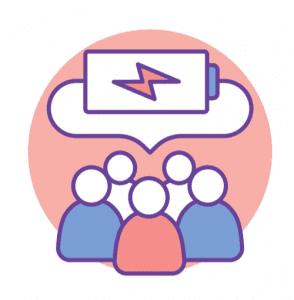
Incentive programs have become increasingly popular as businesses seek new ways to attract and retain customers.
An incentive program is a structured approach that incentivizes employees by offering rewards and incentives, referral bonuses, or cash rewards to individuals or groups for specific actions or behaviors.
These programs are used by businesses of all sizes to encourage employees’ desired behaviors, offering incentives such as rewarding employees for purchasing products or services from other employees, offering incentives for referring new employees working with the company values to customers, or rewarding employees for completing specific tasks.
Types of Incentive Programs
Businesses can use several types of employee incentive programs to work on both incentive schemes and nonmonetary incentives to incentivize employees to achieve financial rewards for completing tasks towards their goals. Some of the most popular motivation and nonmonetary incentives incentive schemes and incentive plans for types many employees include:
Loyalty Programs reward customers for repeat purchases or other loyalty-related behaviors. They often involve point systems, which can be redeemed for rewards or discounts.
Referral Programs –
Referral programs reward customers for referring new customers to a business. These programs can be a powerful way to generate new business, as customers are likelier to trust recommendations from their friends and family.
Sales Incentive Programs –
Sales incentive programs motivate sales teams to achieve specific goals or targets. These programs often involve bonuses or other rewards for achieving particular sales milestones.
Employee Incentive Programs –
Employee incentive programs are designed to motivate employees to achieve specific goals or targets. These programs can improve productivity, reduce turnover, and improve overall job satisfaction.

Benefits of Incentive Programs
There are many benefits to using incentive programs as part of a business strategy. Some of the most important benefits include the following:
Increased Customer Loyalty –
Incentive programs can help businesses build stronger customer relationships, leading to increased loyalty and repeat business.
Improved Employee Performance –
Employee incentive programs can motivate employees to work harder and achieve better results, leading to improved performance and productivity.
Cost Savings –
Incentive programs can be cost-effective in achieving business goals. For example, a referral program can generate new business at a lower cost than traditional advertising.
Improved Morale –
Employee incentive programs can improve morale and job satisfaction, leading to a more positive work environment and lower turnover rates.
Employee incentive programs work
At David T Rosen, employee engagement, employee wellness, professional development, optimal performance, and performance are critical to any thriving business and company culture, and program.
We understand that motivating and retaining top talent for optimal employee performance is an ongoing challenge for many organizations. One of the most effective ways to address this challenge is to engage employees in better workplace performance by implementing employee recognition and incentive programs.
Employee incentive systems and programs are other incentive systems and schemes designed to motivate and reward employees for achieving specific goals, projects, or milestones. These programs can take many forms, from bonuses and commissions to recognition programs and team-building events.
By using positive employee behavior as incentives and offering tangible rewards and recognition to top performers, companies can create a more engaged and motivated workforce, resulting in boosted morale and employee morale, increased productivity, more performance metrics, higher job satisfaction, grew confidence, and employee morale, and better retention rates.

Here are some of the most effective employee incentive programs that we recommend:
Performance-Based Incentives:
This incentive program rewards employees for achieving specific performance goals, such as meeting sales targets, reducing costs, or improving customer satisfaction. These programs typically offer financial incentives, such as bonuses or commissions, to employees who meet or exceed their goals.
Recognition Programs:
Recognition programs are designed to acknowledge and reward employees for their hard work and contributions. These programs can take many forms, such as employee of the month awards, peer recognition programs, or public recognition at company meetings or events.
Wellness Incentives:
Wellness programs are becoming increasingly popular as a way to improve employee health and well-being. These programs can include employee incentives to participate in fitness challenges, health screenings, or wellness workshops.
Education and Training Incentives:
Investing in employee education and training can be a powerful motivator. Companies can offer incentives such as tuition reimbursement or paid time off for employees who pursue advanced degrees or certifications.
Team-Building Incentives:
Team-building incentives can help foster a strong sense of camaraderie and collaboration among employees. Companies can offer incentives such as company outings or team-building events to help build stronger bonds among team members.
Maximize the effectiveness of employee
To incentivize employees and maximize employee benefits and the effectiveness of multiple uses of employee incentive plans and cash compensation programs, it’s essential to take a strategic approach to the whole incentive plan recognition program and cash compensation system. Here are some best practices for designing and implementing successful employee incentive plans and sales performance, program and cash awards programs:
Define Clear Goals:
Before implementing any employee incentive program, defining clear and measurable goals is important. What how precisely what specific behaviors or outcomes are you trying to encourage? How precisely how will you measure the program’s success?
Tailor Programs to Employee Preferences:
Different employees may be motivated by multiple benefits and different types of incentives. It’s important to offer a range of options to employees to ensure that everyone can participate in a program incentive scheme that is mutually beneficial, meaningful, and mutually beneficial to the company’s values.
Communicate Effectively:
Clear communication is critical to the success of any incentive program. Ensure that employees understand the program’s goals, the rewards, non monetary incentives, and cash bonuses that are available, and the criteria for earning those monetary incentives and noncash bonuses, incentives, and rewards.
Monitor and Evaluate:
It’s important to regularly monitor positive employee behavior and employee feedback and evaluate the effectiveness of your incentive programs. Are they achieving the desired results? Are employees engaged and motivated? Use this employee feedback to refine and improve your programs over time continually.

Best Practices for Incentive Programs
To ensure the success of your incentive program, here are some best practices to follow:
Keep it Simple –
Incentive programs should be easy to understand and participate in. Avoid complex rules or requirements that may discourage participation.
Make it Personal –
Rewards should be on flexible schedules tailored to the individual preferences and interests of the participants. This incentive system can help with personal performance and professional development, increase motivation, and increase employee engagement.
Be Transparent –
Clear and transparent communication is essential to the success of an employee wellness incentive and recognition program. Participants should understand the various employee benefits and wellness incentives program’s objectives, rules, and rewards.
Offer a Variety of Rewards –
Providing a variety of rewards channels and employee incentives can help to boost morale and increase employee engagement, engagement, and motivation. Consider offering cash rewards, noncash incentives, and rewards channel partners to cater to different employee incentive program preferences.

Designing Effective Incentive Programs
To design an effective incentive program, you need to consider several factors, including the type of incentive program, the goals you want to achieve, and the budget you have available. Here are some best practices to follow:
Set Clear and Specific Goals: Your incentive program should have clear and specific goals that align with your overall business objectives. Define what you want to achieve and how you will measure success.
Define Measurable Metrics: Your incentive program should have measurable metrics that are easy to track and evaluate. Examples include sales targets, productivity levels, and attendance rates.
Choose Relevant Rewards: Your rewards should be relevant and meaningful to your employees. Consider their needs and preferences and choose rewards that are attractive and motivating.
Communicate Clearly: Your employees should understand the incentive program and how it works. Communicate the rules, requirements, and rewards clearly and consistently.
Measuring Incentive Program Effectiveness
To ensure the success of your incentive program, you need to measure its effectiveness and make adjustments as needed. Here are some tips on how to measure your own incentive system and rewards program that’s effectiveness:
Track Performance Metrics:
Use performance metrics to track the progress and success of your incentive program. Compare results before and after the program implementation to assess its impact.
Collect Feedback:
Gather feedback from your employees on the effectiveness of the last incentive scheme or program. Use surveys, focus groups, or one-on-one interviews to collect feedback and suggestions on the incentive scheme.
Analyze Cost-Benefit Ratio:
Analyze the cost-benefit ratio of the incentive program. Calculate the program’s total cost and compare it to the benefits achieved to determine if the program is cost-effective.
Creating a Successful Employee Incentive Program
We believe that motivated employees are essential for success. Employee incentive programs are a great way to keep your team engaged, productive, and satisfied. In this article will explore the critical elements of a successful employee incentive program.
Identify Your Goals
The first step in creating an employee incentive program is to identify your goals. What do you hope to achieve with the program? For example, do you want to increase sales, improve customer satisfaction, reduce absenteeism, or boost productivity? Next, you can design an incentive program that aligns with your business objectives by setting specific and measurable goals.
Select the Right Incentives
The next step is to choose the right incentives. Incentives can take many forms, such as monetary incentive, rewards, gift cards, extra time off, or recognition programs. It is essential to select incentives that appeal to your employees and are aligned with your goals. For example, offering extra vacation days may be an effective incentive if your goal is to reduce absenteeism.
Communicate
Clear communication is essential for the success of any employee incentive program. Make sure that your employees understand the goals of the program, the criteria for earning incentives, and the available rewards. Consider using visual aids like diagrams or infographics to make the program more engaging and easy to understand.
Track Progress
Tracking progress is an important part of any employee incentive program. By monitoring performance and tracking results, you can identify areas for improvement and adjust the program as needed. Consider using a dashboard or other tracking tool to make it easy to see how your team’s performance.
Conclusion
Incentive programs are a powerful tool for businesses looking to attract and keep qualified candidates, engage employees, retain talent, keep employees competitive, retain customers, motivate employee, further sales performance, and achieve specific business goals.
By understanding the different types of incentives industry, various monetary incentives, incentive schemes, financial incentives, incentive schemes and programs available, and the benefits they offer for human behavior, businesses can develop effective strategies and determine whether monetary rewards and incentives industry as rewards for human behavior that drive success.
We hope this article has provided valuable information on how incentive programs work and their benefits. If you have any questions or would like to learn more about how to implement an incentive program for your business, please get in touch with us.
We would be happy to help you develop an effective strategy channel for employee incentives, a recognition platform for professional development, and a rewards program that meets your company culture’s unique needs and goals.
CoopBusiness is a revolutionary cooperative business-building platform that empowers individuals to become entrepreneurs, business owners, and financially independent.
As a member, you’ll receive top-level business mentorship, access to our proprietary business systems, and the opportunity to access the funds you want to turn your business ideas into reality.